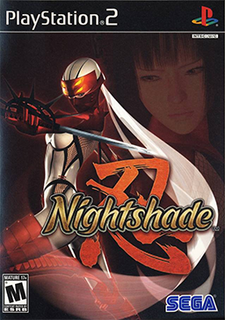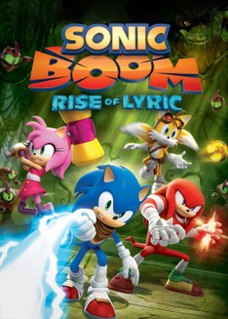Shinobi (忍び) is the Japanese word for male ninja. It may also refer to:

Shinobi (忍) is a side-scrolling hack-and-slash action game produced by Sega, originally released for arcades on the Sega System 16 board in 1987. The player controls ninja Joe Musashi, to stop the Zeed terrorist organization from kidnapping students of his clan.

The Revenge of Shinobi, released in Japan as The Super Shinobi, is a video game developed and published by Sega in 1989. It was the first Shinobi game developed for the Sega Genesis, and was later released on the coin-operated version of that console, the Mega-Tech.

Shinobi III: Return of the Ninja Master, released in Japan as The Super Shinobi II, is an action game developed and published by Sega for the Mega Drive/Genesis console that was released in 1993. It is the direct sequel to the previous The Revenge of Shinobi. The game was originally intended to be released in 1992, and to be very different from the final version of the game in terms of levels and storyline.

Shinobi is a 3D action-adventure video game developed by Overworks and published by Sega as part of the Shinobi series. It was released for the PlayStation 2 console on November 10, 2002 in North America; December 5 in Japan; and May 15, 2003 in Europe. The game stars the master ninja Hotsuma, leader of the Oboro clan, who wields Akujiki, a sword that feeds on souls. He can also use ninja magic, shurikens, and special moves. Upon finding a golden castle after an earthquake, Hotsuma makes it his goal to defeat the powerful sorcerer Hiruko who had summoned hellspawn creatures in Japan to destroy in Tokyo. Hotsuma's mission is to stop Hiroko from destroying the world and avenge the death of his clan.

Shinobi is a series of hack-and-slash action video games created by Sega. The ninja (shinobi) Joe Musashi is the protagonist of the original series of games.

Nightshade, released in Japan as Kunoichi, stylized in all regions with the kanji 忍 behind the title, is an action video game for the PlayStation 2 (PS2), developed by Overworks and published by Sega in 2003. It is the 11th game in the Shinobi series and follows the exploits of a female ninja named Hibana. The game is a sequel to the 2002 PS2 game Shinobi.

The Cyber Shinobi is a side-scrolling action game produced by Sega that was released for the Master System in 1990. It was the third Shinobi game for the console and served as a futuristic-themed sequel to the original Shinobi. The game was released in Canada, Europe, Australia and Brazil, at a time when the Master System was discontinued in other markets.

The G.G. Shinobi (ザ・GG忍) is a side-scrolling action game by Sega released for the Game Gear in 1991. It was the first Shinobi game developed specifically for a portable game platform. The player controls the modern-day ninja Joe Musashi, protagonist of previous Shinobi games, as he goes on a mission to rescue four kidnapped comrades from an enemy, gaining control of the other ninjas as the game progresses in a manner inspired by Mega Man. It was followed by The G.G. Shinobi II: The Silent Fury in 1993. The G.G. Shinobi was one of the first Game Gear games available on the 3DS Virtual Console in March 2012.

Joe Musashi is a player character and main protagonist in Sega's Shinobi series of video games, first introduced in 1987. This original Shinobi hero has achieved great popularity during the late 1980s and early 1990s, when it was used as one of Sega's mascot characters. During this time he was cast as the protagonist of the original arcade game as well the Mega Drive/Genesis sequels The Revenge of Shinobi and Shinobi III: Return of the Ninja Master, also starring in two Game Gear titles. The Mega Drive/Genesis game Shadow Dancer: The Secret of Shinobi also starred Joe Musashi in its overseas release, although the character was originally written to be his estranged son in the Japanese version. In more recent Shinobi titles, he appears as an unlockable character in the 2002's Shinobi and its follow-up Nightshade and in Shinobi 3D, which stars his father Jiro.

Shadow Dancer: The Secret of Shinobi is a side-scrolling action game developed and published by Sega for the Sega Genesis in 1990. It was re-released via emulation services such as the Wii's Virtual Console and Microsoft Windows in 2010, and was also included in the North American version of Sega Genesis Collection for the PlayStation 2 and PlayStation Portable.

The G.G. Shinobi II: The Silent Fury is a side-scrolling action game by Sega released for the Game Gear in 1992. It is the sequel to The G.G. Shinobi, an offshoot of the Shinobi series created for Sega's portable platform. The player controls Joe Musashi as he rendezvous with his ninja allies from the previous game, giving the player access to different characters with unique abilities as the game progresses.

Mario & Sonic at the Olympic Games is a crossover sports and party game developed by the Sega Sports R&D Department. It is the first installment on the Mario & Sonic series. It was published by Nintendo in Japan and by Sega in other regions, and released on the Wii in November 2007 and the Nintendo DS handheld in January 2008. The first official video game of the 2008 Summer Olympic Games, it is licensed by the International Olympic Committee (IOC) through exclusive licensee International Sports Multimedia (ISM), and is the first official crossover game to feature characters from both the Mario and Sonic the Hedgehog series.

Mario & Sonic at the Olympic Winter Games is a 2009 sports and party game developed by Sega. Like its predecessor, it was published by Nintendo for Japan and by Sega for North America and Europe. The game is officially licensed by the International Olympic Committee (IOC) through exclusive license International Sports Multimedia. The game is the third official crossover title to feature characters from both Mario and Sonic's respective universes, the first and second being the game's predecessor Mario & Sonic at the Olympic Games and Super Smash Bros. Brawl respectively. It was released on the Wii and the Nintendo DS in October 2009, and is the first official video game of the 2010 Winter Olympic Games.

Sonic Colors is a 2010 platform game published by Sega. It follows Sonic's quest to stop his nemesis Doctor Eggman from enslaving an alien race and taking over the world. The gameplay is similar to prior Sonic games, with players collecting rings and defeating enemies; the camera perspective often switches from third-person to side-scrolling perspectives. The game also introduces Wisps, power-ups the player can use to increase attack power and reach new areas.

Sonic Generations is a 2011 platform video game developed by Sonic Team and published by Sega for the PlayStation 3, Xbox 360, Nintendo 3DS, and Microsoft Windows. Produced in commemoration of the 20th anniversary of the Sonic the Hedgehog series, the game follows Sonic and his sidekick Tails as they form an alliance with their past selves. It features two gameplay styles: "Classic", which plays from a side-scrolling perspective like that of the original Sega Genesis Sonic games, and "Modern", 3D levels similar to those in Sonic Unleashed (2008) and Sonic Colors (2010).

Sonic & All-Stars Racing Transformed, also known as Sonic Racing Transformed or Sonic Transformed, is a kart racing video game developed by Sumo Digital and published by Sega. It was released for the PlayStation 3, Xbox 360, and Wii U in November 2012, for PlayStation Vita in December 2012, for Microsoft Windows in January 2013, for Nintendo 3DS in February 2013, and for iOS and Android in January 2014. The PS3 and Wii U versions of the game were released in Japan on May 15, 2014.

Sonic Lost World is a 2013 action-adventure platform game developed by Sonic Team. It is part of the Sonic the Hedgehog series, and was released in October 2013 for the Wii U and Nintendo 3DS in PAL regions by Nintendo and by Sega in North America and Japan. A port for Microsoft Windows was later released in November 2015.

Sonic Boom: Shattered Crystal is an action-adventure video game developed by Sanzaru Games and published by Sega in Japan and North America and Nintendo in Europe and Australia for the Nintendo 3DS. Along with its Wii U sibling Sonic Boom: Rise of Lyric, Shattered Crystal is a spin-off of Sega's Sonic the Hedgehog franchise and is a part of the Sonic Boom sub-franchise, which consists also of an animated television series, whose games serve as its prequels. The two games together formed the third and final part in Sega's exclusivity agreement with Nintendo, following Sonic Lost World and Mario & Sonic at the Sochi 2014 Olympic Winter Games in 2013. Both games were released in North America, Europe, and Australia in November 2014. A sequel, Fire & Ice, was released for the 3DS on September 27, 2016.

Sonic Boom: Rise of Lyric is an action-adventure game developed by Big Red Button and published by Sega for the Wii U console. Along with Sonic Boom: Shattered Crystal for the Nintendo 3DS, the game is a spin-off of Sega's Sonic the Hedgehog series and is a part of the Sonic Boom franchise, which also consists of an animated television series, a comic series by Archie Comics, and a toyline by Tomy.



















